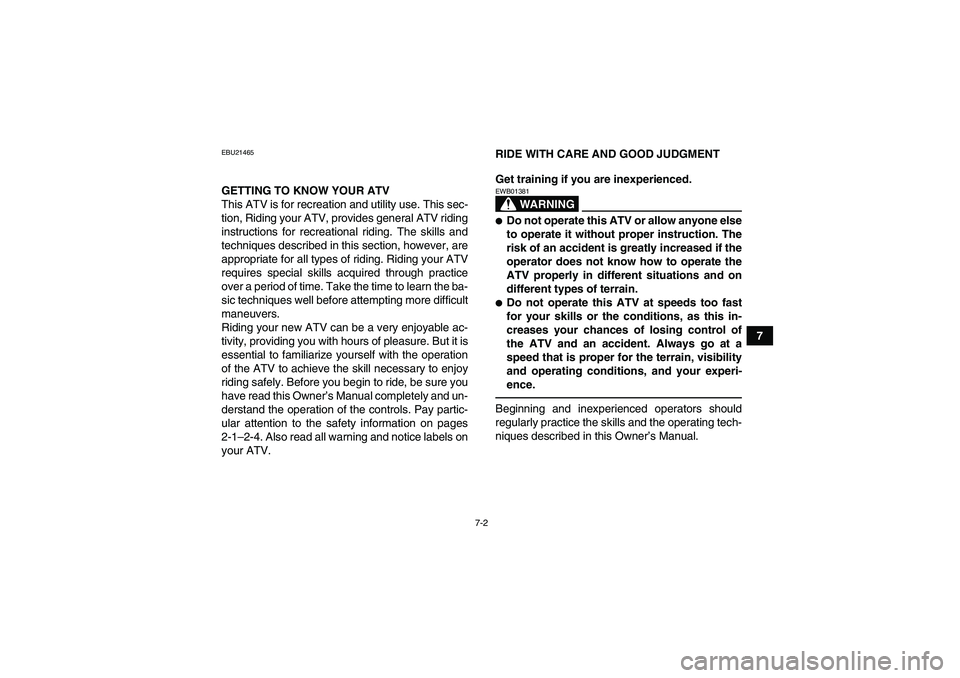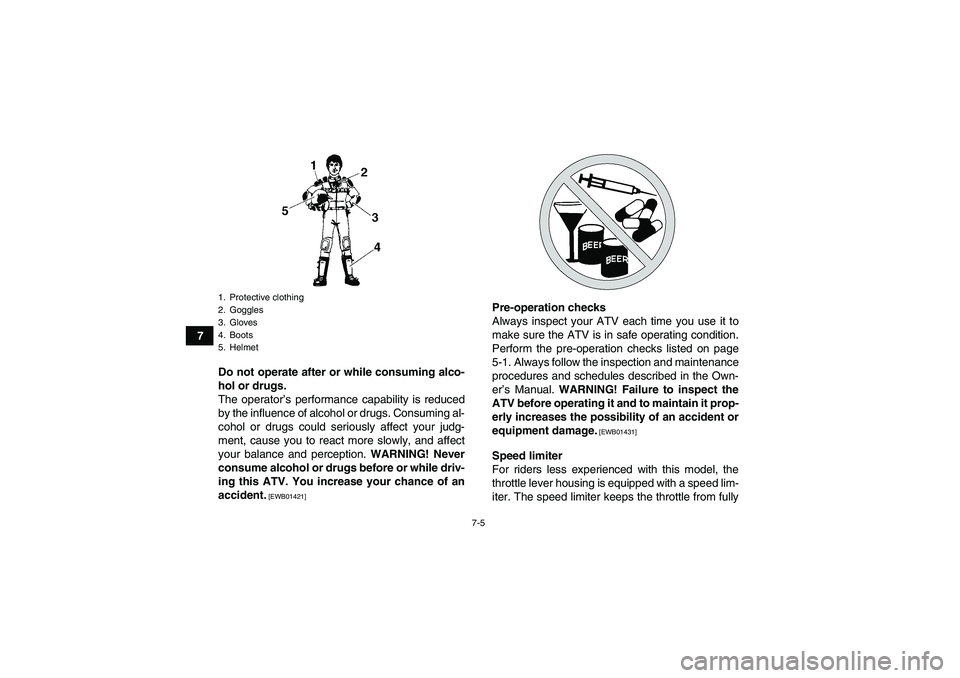Page 50 of 142

6-1
6
EBU19880
OPERATION
EBU19901Read the Owner’s Manual carefully before riding
the ATV. If there is a control or function you do not
understand, ask your Yamaha dealer.
WARNING
EWB00631Read the Owner’s Manual carefully to become
familiar with all controls in order to help pre-
vent any loss of control, which could cause an
accident or injury.EBU20032Starting a cold engine NOTICEECB00150See the “Engine break-in” section on page 6-4
prior to operating the engine for the first time.1. Set the parking brake.
2. Turn the fuel cock to “ON”.
3. Turn the key to “ON” and the engine stop
switch to“”.4. Shift the drive select lever into the neutral po-
sition. The neutral indicator light should come
on. If the indicator light does not come on,
have a Yamaha dealer check the electrical cir-
cuit.
TIPThe engine can be started under the following con-
ditions:�The drive select lever is in the neutral position.�The rear brake lever is applied with the drive se-
lect lever in any position. However, it is recom-
mended to shift into the neutral position before
starting the engine.5. Use the starter (choke) in reference to the fig-
ure:
Position (1):
Cold engine start with ambient temperature
below 5 °C (40 °F).
Position (2):
Cold engine start with ambient temperature
between 0 °C (30 °F) and 30 °C (90 °F).
U1AB60E0.book Page 1 Wednesday, April 29, 2009 10:19 AM
Page 52 of 142

6-3
6
EBU20291Starting a warm engine Follow the same procedure as for starting a cold
engine, with the exception that the starter (choke)
is not required when the engine is warm. Instead,
start the engine with the throttle slightly open.EBU20381Operating the drive select lever and
driving in reverse NOTICEECB00170Before shifting, stop the ATV, otherwise the
transmission may be damaged.Shifting: Forward
1. Bring the ATV to a complete stop.
2. Shift from neutral to forward and vice versa by
moving the drive select lever along the shift
guide.TIPMake sure that the drive select lever is completely
shifted into position.
3. Open the throttle lever gradually.
Shifting: Reverse
WARNING
EWB00720Improper operation in reverse could make you
hit an obstacle or even a person behind you,
resulting in serious injury. When you shift into
reverse, make sure there are no people or ob-
stacles behind you. When it is safe to proceed,
go slowly.1. Drive select lever
2. F (Forward)
3. N (Neutral)
4. R (Reverse)
F2N3R4
U1AB60E0.book Page 3 Wednesday, April 29, 2009 10:19 AM
Page 54 of 142

6-5
60–160 km (0–100 mi) or 0–10 hours
Avoid prolonged operation above 1/2 throttle. Vary
the speed of the ATV regularly. Do not operate it at
one set throttle position.
160–320 km (100–200 mi) or 10–20 hours
Avoid prolonged operation above 3/4 throttle. Rev
the engine freely, but do not use full throttle at any
time.
320 km (200 mi) or 20 hours and beyond
The ATV can now be operated normally.
NOTICEECB00220If any engine trouble should occur during the
engine break-in period, immediately have a
Yamaha dealer check the ATV.EBU20700Parking When parking the ATV, stop the engine, shift the
drive select lever into the forward position, apply
the parking brake, and then turn the fuel cock to
“OFF”.
EBU20760Parking on a slope
WARNING
EWB00830Avoid parking on hills or other inclines. Park-
ing on a hill or other incline could cause the
ATV to roll out of control, increasing the
chance of an accident. If you must park on an
incline, place the ATV transversely across the
incline, shift the drive select lever to the for-
ward position, stop the engine, apply the park-
ing brake, and then block the front and rear
wheels with rocks or other objects.1. Parking brake lock plate
U1AB60E0.book Page 5 Wednesday, April 29, 2009 10:19 AM
Page 56 of 142

6-7
6market products or having other modifications
performed to your ATV that change any of the ve-
hicle’s design or operation characteristics can put
you and others at greater risk of serious injury or
death. You are responsible for injuries related to
changes in the vehicle.
Keep the following in mind when considering an
accessory or operating an ATV which has acces-
sories.
�Accessories should be rigidly and securely
mounted. An accessory which can shift position
or come off while you are riding could affect your
ability to control the ATV.�Do not mount an accessory where it could inter-
fere with your ability to control the ATV. Exam-
ples include (but are not limited to) a heavy or
bulky object attached to the handlebars which
could make steering difficult, an accessory that
limits your ability to move around on the seat, or
one that limits your view.�Use extra caution when riding an ATV with ac-
cessories. The ATV may handle differently than
it does without accessories.
EBU21061Loading
WARNING
EWB00820Never exceed the stated load capacity for this
ATV. Overloading this ATV or carrying or tow-
ing cargo improperly could cause changes in
ATV handling which could lead to an accident.
Cargo should be properly distributed and se-
curely attached. Reduce speed when carrying
cargo or pulling a trailer. Allow greater dis-
tance for braking.Cargo or a trailer can change the stability and han-
dling of an ATV.
You must use common sense and good judgment
when carrying cargo or towing a trailer. Keep the
following points in mind:�Never exceed the weight limits shown. An over-
loaded ATV can be unstable.
U1AB60E0.book Page 7 Wednesday, April 29, 2009 10:19 AM
Page 59 of 142

7-2
7
EBU21465GETTING TO KNOW YOUR ATV
This ATV is for recreation and utility use. This sec-
tion, Riding your ATV, provides general ATV riding
instructions for recreational riding. The skills and
techniques described in this section, however, are
appropriate for all types of riding. Riding your ATV
requires special skills acquired through practice
over a period of time. Take the time to learn the ba-
sic techniques well before attempting more difficult
maneuvers.
Riding your new ATV can be a very enjoyable ac-
tivity, providing you with hours of pleasure. But it is
essential to familiarize yourself with the operation
of the ATV to achieve the skill necessary to enjoy
riding safely. Before you begin to ride, be sure you
have read this Owner’s Manual completely and un-
derstand the operation of the controls. Pay partic-
ular attention to the safety information on pages
2-1–2-4. Also read all warning and notice labels on
your ATV.RIDE WITH CARE AND GOOD JUDGMENT
Get training if you are inexperienced.
WARNING
EWB01381�Do not operate this ATV or allow anyone else
to operate it without proper instruction. The
risk of an accident is greatly increased if the
operator does not know how to operate the
ATV properly in different situations and on
different types of terrain.�Do not operate this ATV at speeds too fast
for your skills or the conditions, as this in-
creases your chances of losing control of
the ATV and an accident. Always go at a
speed that is proper for the terrain, visibility
and operating conditions, and your experi-
ence.Beginning and inexperienced operators should
regularly practice the skills and the operating tech-
niques described in this Owner’s Manual.
U1AB60E0.book Page 2 Wednesday, April 29, 2009 10:19 AM
Page 60 of 142

7-3
7Riding your ATV requires skills acquired
through practice over a period of time.
Do not attempt to operate at maximum perfor-
mance until you are totally familiar with the ATV’s
handling and performance characteristics. Take
the time to learn the basic techniques well before
attempting more difficult maneuvers. Become fa-
miliar with this ATV at slow speeds first, even if you
are an experienced operator.
Not recommended for children under 16 years
of age.
WARNING
EWB01390A child under 16 should never operate an ATV
with engine size greater than 90 cc. Use by chil-
dren of ATVs that are not recommended for
their age can lead to severe injury or death of
the child.
This ATV is designed to carry the operator and
cargo only – passengers prohibited.
The long seat is to allow the operator to shift posi-
tion as needed during operation. It is not for carry-
ing passengers. WARNING! Never carry a
passenger. Carrying a passenger on this ATV
greatly reduces your ability to balance and
control this ATV. You could have an accident,
resulting in severe injury or death to you
and/or your passenger.
[EWB01401]
U1AB60E0.book Page 3 Wednesday, April 29, 2009 10:19 AM
Page 61 of 142
7-4
7 Apparel
Always wear the following to reduce risk of injury in
an accident:
�Approved motorcycle helmet that fits properly�Eye protection (goggles, helmet face shield, or
protective eyewear)�Over-the-ankle boots, gloves, long-sleeved shirt
or jacket, and long pants
An approved helmet and other personal protective
equipment can reduce the severity of injuries in an
accident. WARNING! Operating without an ap-
proved motorcycle helmet increases your
chances of a severe head injury or death in the
event of an accident.
[EWB01411]
Wear eye protection when operating your ATV to
reduce the risk of a serious accident or injury. Eye
protection, such as a face shield or goggles, may
reduce the risk of foreign material getting in your
eyes and help prevent loss of vision. WARNING!
Operating without eye protection can result in
an accident and increases your chances of a
severe injury in the event of an accident.[EWB02611]
U1AB60E0.book Page 4 Wednesday, April 29, 2009 10:19 AM
Page 62 of 142

7-5
7
Do not operate after or while consuming alco-
hol or drugs.
The operator’s performance capability is reduced
by the influence of alcohol or drugs. Consuming al-
cohol or drugs could seriously affect your judg-
ment, cause you to react more slowly, and affect
your balance and perception. WARNING! Never
consume alcohol or drugs before or while driv-
ing this ATV. You increase your chance of an
accident.
[EWB01421]
Pre-operation checks
Always inspect your ATV each time you use it to
make sure the ATV is in safe operating condition.
Perform the pre-operation checks listed on page
5-1. Always follow the inspection and maintenance
procedures and schedules described in the Own-
er’s Manual. WARNING! Failure to inspect the
ATV before operating it and to maintain it prop-
erly increases the possibility of an accident or
equipment damage.
[EWB01431]
Speed limiter
For riders less experienced with this model, the
throttle lever housing is equipped with a speed lim-
iter. The speed limiter keeps the throttle from fully
1. Protective clothing
2. Goggles
3. Gloves
4. Boots
5. HelmetU1AB60E0.book Page 5 Wednesday, April 29, 2009 10:19 AM